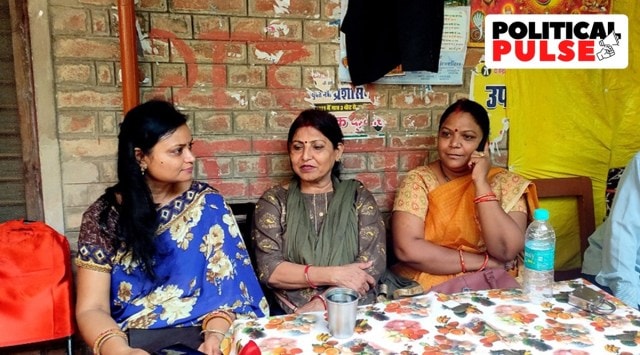It is their petition seeking that they be allowed to pray at ‘a Shringar Gauri Sthal’ inside the complex that led a Civil Judge (Senior Division), Varanasi, to order a videographic inspection. While the mosque management committee has objected to the same, on Thursday, the local court directed that the inspection would go ahead, with a report to be submitted by May 17.

The mosque side had also objected to the Advocate Commissioner appointed by the court for the inspection as “biased”, and on Thursday, the court appointed two more.
While Laxmi Devi, Sita Sahu, Manju Vyas and Rekha Pathak live in Varanasi and have been present at every hearing of the case – which began in August 2021 — the fifth and main petitioner, Rakhi Singh, is based in Delhi and has not been to court.
Singh’s interest seems to originate from her links to the ‘Vishwa Vedic Sanathan Sangh’. The 35-year-old is a ‘founder member’ of the outfit, which claims to have done “coordination” for the petition. Her uncle, Jitendra Singh Bishen, is the president of the Sangh.
Santosh Singh, the UP convenor of the Vishwa Vedic Sanathan Sangh, says the outfit coordinated with four of the women and brought them together to file the Gyanvapi petition in August 2021. “We are managing the whole case.”
Then there is the husband of Laxmi Devi, 65. Sohan Lal Arya, a senior VHP office-bearer in Varanasi, claims it was he who “inspired and brought together the five women (petitioners)”. Arya, 71, is also the “pairokar (litigants’ agent)” in the petition.
Story continues below this ad
The VHP Varanasi Mahanagar vice-president and spokesperson since 1984, he told The Indian Express: “I inspired the five women to file the petition in the Varanasi court. The five women, including my wife Laxmi Devi, were chosen by me.”
Arya, who claims to have been associated with the RSS since childhood, says he filed his first petition regarding the Kashi Vishwanath-Gyanvapi matter in a Varanasi court in 1985. This time, he adds, he decided to put women in the front as it is they who pray to Goddess Maa Shringar Gauri. “I chose the four women as I needed some women to file the petition. I didn’t have any other names, so I picked them.”
The Vishwa Vedic Sanathan Sangh was founded in 2018 “for the cause of Hindutva”. Headquartered in Uttar Pradesh’s Gonda district, it claims to have an office in New Delhi and several other states.
The outfit has also filed cases over the status of Qutub Minar in a New Delhi court (on Tuesday, some Hindu activists tried to recite Hanuman Chalisa there, claiming it was Vishnu Stambh); as well as one regarding the Krishna Janmasthan in a Mathura court, which also involves a dispute with a mosque.
Story continues below this ad
Sita Sahu, one of the five petitioners, has another account of how they came together for the case. “Four of us met at a satsang and decided to file the petition. We were contacted by Rakhi Singh saying she wanted to be a part of the petition, so we included her too.”
Rakhi Singh, 35
The main petitioner, the Delhi-based Rakhi Singh is a founding member of the Vishwa Vedic Sanathan Sangh. Singh has not appeared for any of the hearings in the case, and remained unreachable for comment.
The outfit’s UP convenor, Santosh Singh, says Rakhi Singh “is a social worker working for the cause of Hindutva”. On her interest in the temple-mosque complex, Santosh Singh says: “She has visited Varanasi multiple times and is a worshipper of Goddess Maa Shringar Gauri.”
Laxmi Devi, 65
Story continues below this ad
Laxmi Devi’s husband, VHP leader Sohan Lal Arya, says she is a homemaker who has never been associated with any outfit or organisation. “She barely ever leaves the house,” he adds, including to come to the court hearing. So Arya appears on her behalf.
The couple live in Varanasi’s Mahmoorganj area.
Sita Sahu, 40
The married Sahu runs a small general store from her house in Chetganj area of Varanasi, just 2 km from the complex. While she has never been associated with any outfit or organisation, she says, “we are doing work for Hindu religion and filed the petition because we are not allowed to properly worship our Goddess at the temple”.
Manju Vyas, 49
Vyas runs a beauty parlour from her house located 1.5 km from the Gyanvapi complex and is not a member or office-bearer of any outfit or organisation either. Apart from her small business, she says, she “looks after my family”. Her interest is to pray at the Shringar Gauri Sthal, she says.
Rekha Pathak, 35
Pathak, a resident of Hanuman Pathak area, which is also located in the vicinity of the Kashi Vishwanath temple complex, is a homemaker. She says she became a part of the petition for the cause of her Goddess. “I felt bad that women who go to the temple for worship are not allowed past the barricading, so I became a part of the petition. The decision to file the petition was taken by us during a satsang of the temple because all of us worship the Goddess,” she says.

































